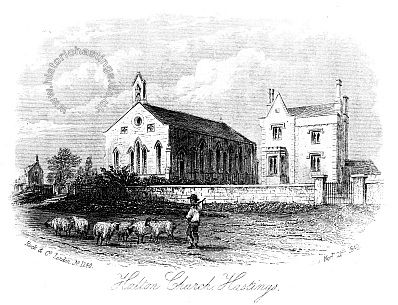
1240 “Halton Church, Hastings”. dated 20th of November 1849. The graveyard of this church can still be seen at Egremont Place, at the top of Mount Pleasant Road. The church and vicarage were demolished and replaced by the 1970s with social housing. Frederick North, MP and father of Marianne North the renowned painter, is buried here.
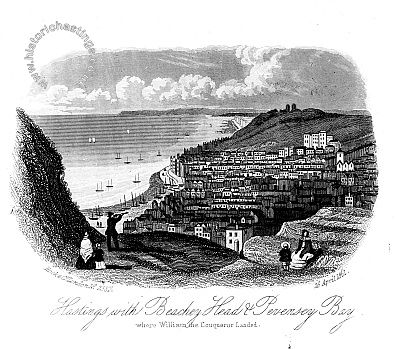
2387 “Hastings with Beachy Head and Pevensey Bay”. dated 26th of April 1861. The Old Town Valley is now quite full of housing and St Leonards can be seen in the distance. Hastings Pier is yet to be built
Rock & Co.
We know that in the 19th century there were at least two different technologies involved in the production of a book with illustrations, letterpress where the printing ink was transferred by the high points of the type and engraving where the ink was transferred from incisions in the printing plate and these two processes were completed by separate, specialist printers. We also know that the finished product was stocked by booksellers who were also trading as libraries. Some guidebooks were produced with very few illustrations and the reader was dependent for local views on pictures supplied by the separate printer of engravings to the bookseller and it by one such specialist, Rock and Co. that these pictures were originally printed
The London publisher Rock & Co. was founded by William Frederick Rock (1801-1890). In the second quarter of the 19th century Rock had gone into business with Thomas de la Rue and this was to last until around 1833 when Rock had made enough money to set up a printing business with his brothers and future brother-in-law and De la Rue is today an internationally recognised firm of banknote and postage stamp printers still specialising in engraving techniques. By the middle of the 19th century Rock & Co. had achieved prominence as a prolific publisher of steel engraved vignette images, producing views for a large number of other localities, not just Hastings and St Leonards. These illustrations were published in the form of cards, fancy stationery, and books and booklets and the were usually numbered and dated within the border of the engraving. Production of books of steel line-engraved vignettes was to endure until about 1880, to be replaced by a newer technology and for a while Rock & Co published albums using the “leporello” process which will be discussed in a future edition. Rock retired in 1884 and died in 1890 when his collections were left to the North Devon Athenæum.
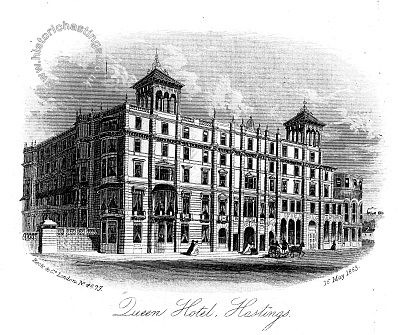
4679 “Queen Hotel, Hastings” dated 16th of May 1863. The hotel had opened in March the previous year. It has lost the two turrets on the top, and, as Queens Apartments, is easily recognisable today. Notice the steam train on its embankment on the extreme right of the picture.
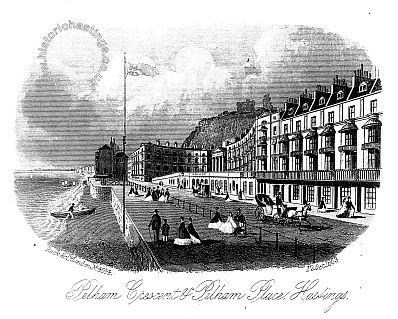
4814 “Pelham Crescent and Pelham Place Hastings” dated 12 October 1863. Notice the “Russian Run” captured in the Crimea and sent for scrap during the Second World War. The buildings shown behind the flagpole were demolished in the 1930s as part of Sydney Little’s seafront improvements, notice how narrow the promenade was. Pelham car park now covers the area to the left of the picture.
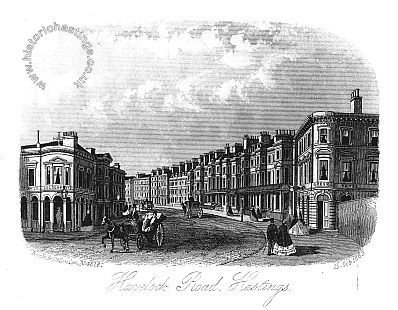
4816 “Havelock Road Hastings” dated 15th of October 1863. Looking down from Hastings station Greens Hotel is on the right, also known as the Station Hotel lasted until around 1970 when it was demolished and replaced with Queensbury House, the buildings to its left have been recently demolished and replaced with modern offices. The Old Golden Cross the on the left, is still there today as a student bar.
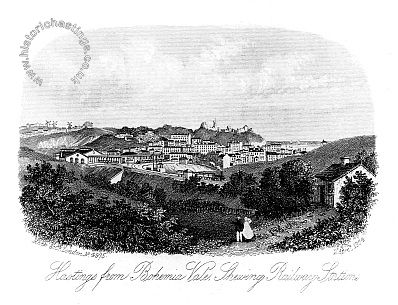 4975 “Hastings from Bohemia Vale, Shewing Railway Station”. Dated 24th of April 1864 with Hastings station clearly in the centre. The railway bridge is the one at the end of Braybrooke Road.
4975 “Hastings from Bohemia Vale, Shewing Railway Station”. Dated 24th of April 1864 with Hastings station clearly in the centre. The railway bridge is the one at the end of Braybrooke Road.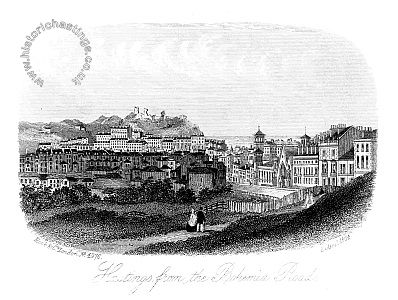
4976 “Hastings from the Bohemia Road” dated 2 April 1864. On the right, and easily recognisable is the lower end of Cambridge Road, the buildings in the centre of the picture may well be the remains of the Priory farm and the foreground will later be occupied by Cambridge Gardens.
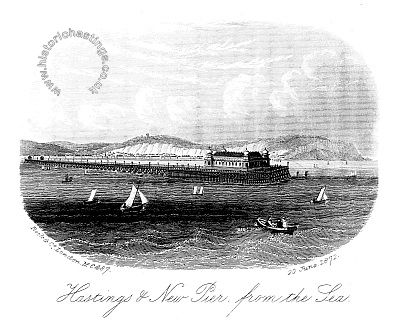
6487 “Hastings and the New Pier from the sea” dated 20th of June 1872. The pier didn’t actually open until the first ever August Bank Holiday later that year, construction having been started in December 1869.